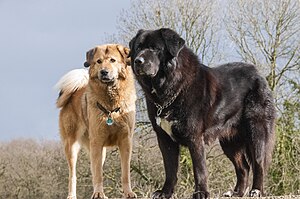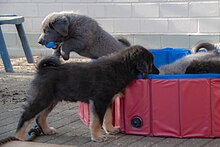Do khyi
| Do khyi | ||
|---|---|---|
|
|
||
| FCI Standard No. 230 | ||
|
||
| Origin : | ||
| Patronage : |
FCI |
|
| Alternative names: |
Tibetan mastiff, Tibetan mastiff |
|
| Withers height: |
Males ≥ 66 cm, |
|
| List of domestic dogs | ||
The Tibetan Mastiff , also Tibetan Mastiff or Tibetan mastiff or Tibetmastiff called, is one of the FCI recognized breed of dog from Tibet ( . FCI Group 2, Section 2.2, Standard No. 230 ). The FCI is developing the breed standard of this herd protection dog .
Origin and history

The type of shepherd dog called Do Khyi (translated: tethered dog) in Tibet comes from the high plateaus of the Himalayas and Transhimalaya and is known as one of the oldest dog breeds in the East . In contrast to many other shepherd cultures, dogs are held in high esteem in Tibet and were also used in the depiction of the “ wheel of life ” on a number of ancient thankas and paintings. Thanks to this, the unchanged type of dog can be proven back over a long period of time. In Europe , people first became aware of this breed of dog through the traditions of Marco Polo , who traveled to Asia around 1271 and reported on the culture and people of the Tibetan highlands.
The thesis that the Tibetan mastiff is the ancestor of all mastiff-like dogs was raised a long time ago (1875–1935) and has since been discussed controversially among cynologists , but has now been clearly refuted: In studies of the mitochondrial DNA of various dog breeds , four Tibetan mastiffs were also Region of origin included. The Tibetan mastiffs examined are on haplotype 44 and 45 of the oldest domestication group A and have remained fairly unaffected by later influences on the mitochondrial DNA. In their company there are also some street dogs on haplotypes 44 and 45 from the regions of Sichuan (former historical Tibet, Kunlun Shan plateau, East Quamdo, Amdo, northern India) and Guangxi (below the Himalayas and inner Mongolia ). The influence of the street dogs on the Tibetan mastiff or the Tibetan mastiff on the street dogs is clearly visible.
Because the Tibetan culture was largely isolated from Western and Asian influences due to its geographical isolation, at least until 1959, it can be seen that this breed (like some other old domestic animal breeds that survived in the seclusion of Tibet) in the past centuries without genetic influence from outside received relatively unchanged. However, haplotypes 44 and 45 play a much smaller role in the development of other haplotypes than previously thought. The street dogs of Tibet and the Tibetan mastiff played a role in the development of other dog types, but they are not the ancestors of today's western Molossians .
In its mitochondrial DNA, haplotype 45 indicates the development from the determined, involved wolf subspecies (haplotype 35). Via an unknown intermediate type, this also leads directly to haplotype 44. The proximity to the original ancestor, the Mongolian wolf ( Canis lupus chanco ) named in the study , is also proven with these results.
description
The breed is over 66 cm tall and weighs around 60 kg (males), is strongly built and can be found in the colors monochrome black, monochrome red, monochrome blue, black marks or as blue and tan colors. A smaller white star on the chest and small white markings on the toes are possible. The hair is dense with a very strong undercoat in winter, usually in a kind of long-stick hair. The top coat is firm and, together with the dense undercoat, very insensitive to the weather. The hair on the head and above the neck forms a ruff, especially in males.
Characteristic of this dog breed is the heavy shedding in the spring months, which allows them to adapt to the strong seasonal temperature fluctuations in their home. The undercoat, parts of the outer hair and the top layer of skin (flaking) are shed. After shedding the undercoat, the dog has a changed, significantly slimmer appearance.
The dog has an almost square structure with good, functional angles of the fore and hindquarters and a strong neck and neck area. He carries the strong feathered tail rolled over his back. The head of the adult dog is heavy and broad, but is still in a harmonious relationship to the body. The ears are rather small to medium-sized and are carried hanging on the side of the head, but also pointing forward when paying attention. The dentition is strong and usually shows a scissor bite , but sometimes there is also a pincer bite. The lips show a good finish despite a strong training.
Essence
The Do Khyi is a very reliable dog who is loyal and loyal to its people. He is quick to learn, but is also quick to get bored. An eagerness to learn was not part of his original requirement profile, and he has qualities that make him an excellent watchdog .
The Do Khyi has a pronounced territorial behavior and behaves very confidently on its own terrain. Guard dog characteristics are innate to this breed: He is reserved and deliberate towards strangers and as guardian of the house and yard in his traditional task. In its region of origin, where fences and walls are practically unknown as property boundaries, it defends the property of its owners up to its boundaries, which are marked by stones. A Do Khyi should find a varied environment in which he can pursue his traditional task.
Furthermore, Tibetan mastiffs behave quite calmly in the house, whereas they can be lively and playful outside. Tibetan mastiffs have a deliberate, energy-saving drive to move, that is, they are not dogs that, in addition to their daily long walks and exercise in the garden, absolutely need certain sporting activities.
Social aspects
The Tibetan mastiff is in principle suitable for family life if it grows up in this familiar environment from the start. Once well socialized, the Tibetan mastiff will regard pets (including small animals) as part of the family and protect them accordingly. The Tibetan Mastiff behaves dominantly towards other dogs, especially males; Although they are not belligerent dogs, they are very defensive and do not avoid potential attackers.
use
In his homeland, the Do Khyi is still an indispensable and omnipresent part of the court and family communities there.
Due to the increasing tourism in the Himalayas, mixing with other dogs brought by travelers can no longer be ruled out, despite all the remoteness of the home region of the Tibetan mastiff. Also because the Tibetan mastiff has recently been valued by wealthy Chinese as a status symbol and very high prices are being paid for these dogs, the future of dogs tends to be in jeopardy, because it can be assumed that many dog breeders will be much more interested in the potential proceeds than in sustainable ones Are interested in breeding. In Germany, an average of 19 Do Khyi were littered annually between 2003 and 2017 in the Association for the German Dog System. The puppies there cost 950 to 1000 euros. Outside of Asia, the Do Khyi has been bred since 1976 (USA) and 1979 (Europe) based on a few imported dogs from neighboring regions of Tibet ( Nepal , Bhutan , Northern India).
Legal position
The Tibetan mastiff is on the breed list of potentially dangerous dog breeds in the Swiss canton of Ticino , and keeping it there requires a permit.
Individual evidence
- ↑ Peter Savolainen, Ya-ping Zhang, Jing Luo, Joakim Lundeberg, Thomas Leitner: Genetic Evidence for an East Asian Origin of Domestic Dogs. In: Science . Vol. 298, No. 5598, 2002, pp. 1610-1613, doi : 10.1126 / science.1073906 .
- ↑ puppy statistics. In: vdh.de. Retrieved January 22, 2019.
- ↑ Chinese woman buys a dog that costs 400,000 euros. In: spiegel.de. September 11, 2009, accessed January 22, 2019.
literature
- Joan Palmer: The Illustrated Encyclopedia of Dog Breeds. Wellfleet Press, Edison NJ 1994, ISBN 0-7858-0030-1 .

